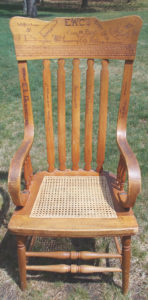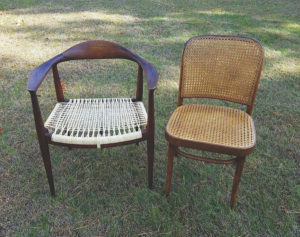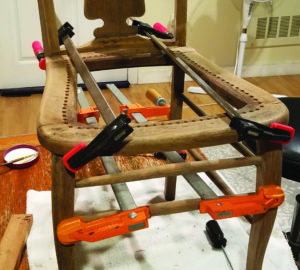My great-grandmother Bernice Newcomb did chair caning out of her home in Wellfleet in the 1920s and ’30s. I grew up in that house, where my mother did chair caning, too — though her jobs as town clerk and treasurer in Wellfleet didn’t leave much extra time for the craft.
I would observe my mother as she worked, but I wasn’t formally trained. Seat weaving was just a handy skill to have. I started taking my mom’s overflow work, and when I was a teenager, I got paid $50 a chair, which seemed like pretty good money to me then. Later, when I was raising my kids, I could supplement the family budget with chair caning work.

The “cane” of a woven seat is rattan, which grows on a vine in Indonesia. The glossy bark of the vine gets cut to different widths and thicknesses and is used to construct furniture.
Many chairs that come my way were inherited. New manufactured chairs can’t compare to chairs made from old growth hardwood. Today, when poorly woven chairs end up blowing out, customers usually end up buying another chair. But a hand-woven chair can rock babies from generation to generation. People seem happy to find someone who can put their family heirlooms back in good working order.

Each chair is different and tells its own story. I had a customer from Chatham who brought in a big rocking chair that was dirty and blown out. The chair had writing and autographs burned into the wood. It had belonged to its owner’s grandfather, whose fraternity brothers — class of 1897 — had signed it. I’m also a genealogist, so, of course, I had to look up the names. The chair was almost like a snapshot in time. I gave it a new life.
My son is a UPS driver on Nantucket. One day he brought me a few chairs that he picked up from the side of the road. A couple of them were garden variety, one was a ladderback, but the fourth one was special. I talked to a friend in the fine furniture trade, and it turned out to be an 1870s Chippendale ribbon back chair. When I took off the upholstery, it was a sight to behold. But the seat was rush, which isn’t my material. My mom replaced the rush seat, and now my son uses it as his computer chair.
People on the Outer Cape admire Marcel Breuer’s architecture; he was also a big chair designer. Each midcentury modern designer had a vision for the weave in the chair. Retaining the value in those pieces means authentically replicating the woven material. I’ve done some Hans Wegner chairs that weren’t replaced with the correct weave. I had to research the correct technique. With chair caning, there are always new patterns to learn and discover.

I’m a chair nerd. I belong to the Seat Weavers Guild, and our Facebook group for guild members is called “Canespotting.”
The chair caning business is booming. I currently have 20 chairs in my queue to be worked on. Most chair caners do their work from home, in little workspaces cut into a spare room. When I start working on a chair, I first remove the old material and clean the chair. I figure out what size material to use, and make sure the chair edges that will be in contact with the weaving are smooth.
It’s not an inexpensive thing to replace a seat, so I like the material to last a long time. We found an old receipt book of Bernice Newcomb’s. She charged two cents a hole. I often wonder what she would think about 21st century prices. Some of my chairs are five dollars a hole.

Every year, the Seat Weavers Guild has a gathering. This year, it was supposed to be in Hull. Now we’re planning it for next year. Thanks to their outreach and education, there’s a new crop of people coming up trained in chair caning. And then there’s the old weavers. I’m somewhere in the middle. The experience of the old and the technical savvy of the young will help to make sure the seat weaving craft survives and thrives.
